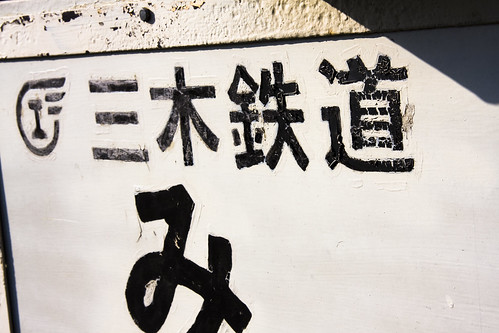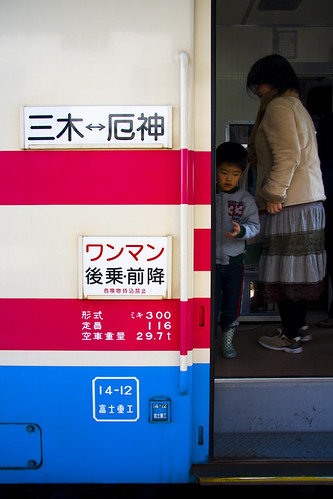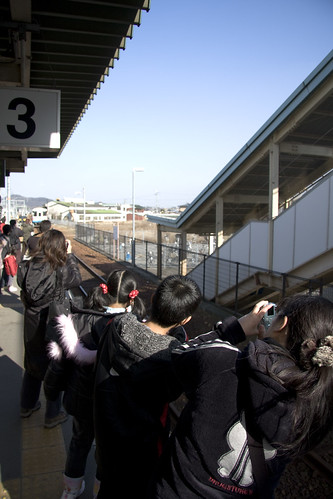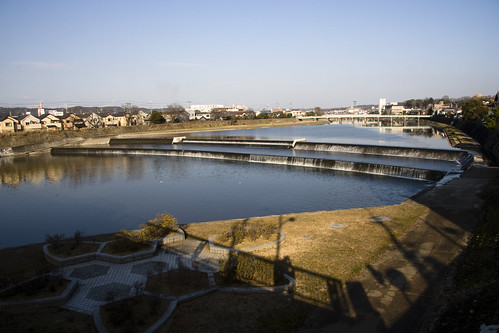Station sign-Miki Railway, Miki Station
At the end of March the Miki Railway will cease to exist. The small single track, single car, 6.6km long, 9 station rail line connects the Miki city center to the JR Kakogawa line. In 1985 the Miki line broke off from the national JR network during its reorganization and formed into a new thrid-sector (not for profit) company with ties to the city administration. It will be the fifth of these third-sector rail lines to close since the reorganization.Boy Standing in the door of a Miki Railway train
I have some possible hypothesis for this closure. Is it the aftermath of an overbuilt national infrastructure that cannot support itself? Was this the eventual outcome for the line, but delayed by making it non-profit to lessen public outcry? Is this line just geographically un-profitable? I believe these three factors all played a major role in the railway’s decline. The pressure from the for-profit and much more efficient--albeit quite expensive--Kobe Electric Railway (Shintetsu) also helped exacerbated the situation. (Shintetsu runs more directly towards Kobe and Osaka, the largest local population centers and most likely the direction most residents of Miki would be traveling. The Miki Railway travels away from Kobe then connects to the less frequently run JR Kakogawa line. A quick example search of timetables on hyperdia shows that a route using Shintetsu from their Miki station to Sannomiya (downtown Kobe) would take about and hour and cost 720 yen. The same route using Miki Railway would take about an hour and a half and cost 1070 yen.)
Children taking photos of the a Miki Railway train coming into Yakujin Station
Another aspect of the closure has been the increase of tourism by families, train fanatics, and other curious people. While I was aware of the line, its immediate closure lead me to ride it last monday, a national holiday. The train was packed. At every station there was at least two people, sitting by their cars most of the time, taking photos of the train as it pulled up to the rickety wooden platforms that served as the stations. (Miki Railway runs like much of JR’s rural one-man routes with passengers paying the driver as they exit much like a bus.) In the train I was squished up against the front middle window next to the drivers booth, a prime photo spot. Around me there were a handful of middle aged men and one woman with various high-end SLR cameras. These were the densha otaku--train nerds. Then there were the less hardcore nerds and families using normal point and shoot cameras or their cell phones to capture the moment.
But a moment of what?
"Sayonara Miki Railway"
I am a moderate train nerd. I love riding the trains, but I’m definitely not as obsessive as some people. I came to ride this line before it closed. But I realized at that moment as I was couched down and staring out the dirty, fingerprinted window (how can you take a good shot through that), that I was there with a car full of people documenting the death of something. We were riding a dying horse to its stable for the last time. The grandfatherly figure driving the train didn’t seem at all overtly fazed by all these people, but there was a sense of sadness about him. All these people, and it will probably like this until the last day, coming to document his loss of a job--and quite likely an entire lifestyle too. I wondered if he was angry at us, if he thought that we could have saved his train if we just supported it before it was slated for closure. Of course I don’t know the answer to this. The train driver, and every other employee of the Miki Railway were all very, very busy so I didn’t have the chance to ask. You see at the main Miki station, the only station on the line with a staff, there were commemorative stamps and goods for sale. I bought a keychain, but there were phone straps, books, DVDs, toy trains, and rice crackers for sale--many of them sold out. The staff all looked as tired as the weather worn wooden building they were in.
Miki city
I came to Miki to ride the Miki Railway, I thought it would be a fun experience, but I left with a strange sense of sorrow. Humans revel in watching the despair of others. Is failure more attractive than success? Wether the death of the Miki Railway was predetermined by geographic or economic factors or not the clamor over that death shows that the failure might have an edge.
Hojo Railway train
But there is a bright side of this story. I also took this chance to ride the Hojo Railway. Similar in style and history to the Miki Railway, the Hojo Railway was bright and shining. The stations had the same rickety wooden construction, but appeared to be well maintained. Many flowers and other plants were planted in and around the stations. Signs, seemingly painted by local school children, advertised Kasai city as a “city of flowers.” The riders were upbeat and posters in the train celebrated the high ridership of the local train lines--oddly enough including the Miki Railway--and telling them that the more they used them the lines the more convenient they would become.
On the way home drinking cup-sake as the picturesque landscape of the sun setting on rural Japan slowly rolled by, the sadness I felt earlier had all but left me. The knowledge that community based not for profit mass transit can work made me happy. This time I wasn’t documenting demise, but instead celebrating life.
Link to my route on Google Maps.
Link to the set of photos I took on this trip on flickr.






4 comments:
Hi, you wrote that Third-Sector Companies are not for profit. Well, they are not for profit, but they are also not to make losses all the time. Third sector is common in Japan, and means a cooperation of public and private enterprises, although in most cases it is the public pushing something trough with only little effort by the private companies involved.
The railway closed first of all, because the city (which is the main stockholder) obviously is not so interested in it. They could have tried to integrate it into city planning, could have extended it to the Kobe Dentetsu via city hall. The railway lost 50% of its passengers in the last 20 years, and did the city take any action?
Of course, the main commuter flow from Miki must be to Kobe, and the Miki Railway connects to Kakogawa, so that is a disadvantage, without doubt.
By the way, the railway was opened as a private railway in 1916, and nationalized in 1943.
But you are correct, it is a sad development, and also normal in Japan that railfans and others rush to see/photograph and ride a train during the last months of its life.
Thank you for your comments.
As I don't have the time or Japanese ability to fully research the situation as of yet, I tried to give as basic, yet informative, overview of the situation to put the photos in context to some degree.
I wasn't too sure about the actual running of the railway I left it at non-profit (perhaps not-for-profit might have been better wording) in the post rather than expand on the relation of third sector companies to city/prefecture/national government.
Thank you for those numbers. They say a lot but it makes we wonder why they didn't just abandon it during the JR break up--going back to one of my hypothesis. Was the line profitable prior to the break up? Who constituted the major ridership? School children? Salary men? The lack on interest on the city's part is sadly not surprising.
Personally I doubt that even extending it thought to Shintetsu would have made much a difference, and would have cost a lot to go though those neighborhoods given their location and age. What market would it support? People between Suzurandai and Miki who want to go to Himeji? That group of people can't be too large and can be done by changing trains at Ao.
Thanks for the dates. I was aware them from the on the Japanese Wikipedia page but chose not to include them, which, in hindsight, I should have.
I'm going to try to post more things like this in the future. (Which means, hopefully, my job will get easier soon.) I hope you continue to read and comment.
For those who would like to duplicate sleepytako's ride on the Hojo Railway but can't get to Japan, there's a great video of th entire line taken from the front of the train here:
http://www.youtube.com/watch?v=4ISTUWmZf1U&feature=channel_page
Just one question: why would the track connecting this branch line and the main line at Ao have been removed?
I'm not sure what you mean. The JR West and Shintetsu lines are still running to Ao.
Thanks for linking the video!
Post a Comment